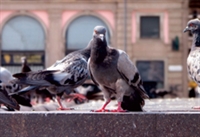
When you think of pests, visions of cockroaches, ants and flies may come to mind. Add flying pests to the mix, and you may conjure images of flies, wasps or mosquitoes.
But what about birds? Can they be pests, too?
Absolutely.
In addition to being a nuisance, pest birds like pigeons, house sparrows and starlings can cause serious health risks, making them particularly troubling at long-term healthcare facilities. In fact, according to the Centers for Disease Control and Prevention, bird fecal matter can contain disease organisms such as histoplasmosis, toxoplasmosis or cryptococcus, which can cause serious health issues. Also, bird ectoparasites including mites can bite people.
 Pest pigeons, which breed in urban and suburban areas, can transmit diseases and damage structures. The tiny house sparrow can overtake native species and build unsightly nests on building ledges and rooftops. Starlings can descend in large numbers on the trees surrounding your facility, nest in wall cavities and flock in droves.
Pest pigeons, which breed in urban and suburban areas, can transmit diseases and damage structures. The tiny house sparrow can overtake native species and build unsightly nests on building ledges and rooftops. Starlings can descend in large numbers on the trees surrounding your facility, nest in wall cavities and flock in droves.
These pests can damage your facility and negatively impact surroundings, too. Pest birds cause tens of millions of dollars in damage every year to machinery, automobiles, light standards, roofs and ventilation systems. They deface walkways, courtyards and building entrances, and their fecal matter’s high nitrogen content can corrode metals and other building materials.
Pest birds often make their presence known during the late spring as the temperatures get warmer and young fledglings start leaving their nests. That’s why now is the time to take action if you haven’t already.
The good news is that a strong Integrated Pest Management (IPM) program can help ground these threats from above. IPM focuses on proactively controlling pests through sanitation, facility maintenance and exclusion techniques.
Talk with your pest management professional about setting up a bird control program for your property, and consider using these IPM strategies to help create a suitable air defense.
Study up
Before diving into a solution for your pest bird problem, you must first understand “what, where and why” the problem exists. Conduct frequent inspections around the grounds to see where bird pressures are building. Ask your pest management professional to provide a written service report with recommendations on control options.
Clean up
Pest birds are often drawn to common areas because employees, guests and patients alike give them reason to hang around. By feeding birds directly or leaving crumbs, scraps or trash outside, they encourage the birds to nest and roost on the structure.
Consider posting signs to deter people from feeding birds. Also, use liners for trash cans keep these bins, trash compounds and employee break areas clean and free of food debris.
Look up
Roofs can often be overlooked when developing a pest management plan, but they can be a real hot spot for pest birds – and other pests. Roof ledges can provide the perfect perch for birds and their nests, and rooftop HVAC units can create openings or leaks that attract pests.
Regularly inspect your roof and rooftop HVAC units for evidence of any bird activity, as well as openings, cracks or crevices, and clean up puddles of water left after rain showers. Repair leaky HVAC systems and ensure that the drain lines for these units are in good condition. These steps will reduce likelihood of birds nesting or roosting on rooftops.
Partner up
When it comes to advanced control techniques, it’s best to talk with your pest management professional. Your provider will identify what problem bird species are present, where they are feeding, roosting, nesting and loafing, what risks they pose and the best solutions to resolve the issues.
Some of these tactics include mechanical traps, electronic control devices and specialized non-toxic repellents. If you are already facing significant pest bird pressures, you can ask your pest management professional about installing bird wire, electric track or other appropriate bird management systems at the roofline to prevent roosting.
By taking these steps, you can help keep your facility a no-fly zone for pest birds.
Patrick Copps is Technical Services Manager for Orkin’s Pacific Division. An entomologist in urban and industrial entomology, Copps has more than 35 years of experience in the industry. For more information, email him at [email protected] or visit www.orkincommercial.com.



